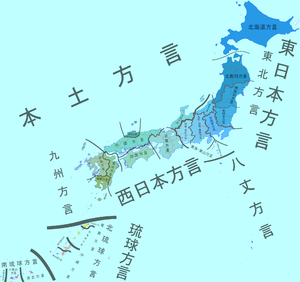日琉語族
日本列島で使用されている日本語及びそれに類する言語群
日琉語族︵にちりゅうごぞく、英語: Japonic languages, Japanese-Ryukyuan languages︶または日琉諸語︵にちりゅうしょご︶、日本語族︵にほんごぞく︶とは、日本列島で話される語族である。日本本土で話される日本語と、奄美群島から先島諸島にかけて︵南西諸島、琉球諸島︶話される琉球諸語が主に属する。奈良時代ごろには東国で上代東国語が話されていた。
| 日琉語族 | |
|---|---|
| 日本語族 | |
| 話される地域 | |
| 言語系統 | 世界の主要な語族の一つ |
| 祖語 | 日琉祖語 |
| 下位言語 | |
| ISO 639-2 / 5 | jpx |
| Glottolog | japo1237 |
 区分の一例(ここでは日本語派を本土方言、琉球語派を琉球方言としている) | |
アイヌ語・ウィルタ語・ニヴフ語も日本列島北部で話されている(話されていた)言語であり、特にアイヌ語は日琉語族といくつかの語彙を借用しあっていると考えられるが、日琉語族とは系統が異なる。
概要
編集日本と琉球の関係性は日琉同祖論などと呼ばれ、指摘するものは以前からいたが、近代的な比較言語学に基づく厳密な研究は服部四郎に始まり[1]、現在までに多くの研究者が日本語と琉球諸語の間の複数の規則的な対応関係を示している[2][3][4][5][6]。
「日本語#研究史」も参照
分類
編集ペラールによる系統分岐
編集
日琉祖語はまず日本本土と琉球諸島の2つの語派に分かれたと考えられるが、八丈語の歴史的位置は不明である[9][10]。
トマ・ペラールは、諸言語の共通の改新に基づく系統分類を行った[11]。これは表面的な類似に基づく分類とは性質が異なる[8]。UNESCOのいう﹁国頭語﹂なる系統は存在せず、北琉球語群は二つに分類できるとされる[12]。
五十嵐による系統分岐
編集五十嵐陽介は共通改新に基づく系統分類を行い、琉球諸語は南部九州の言語と同系統、八丈語は糸魚川・浜名湖線以東の言語と同系統であり、「本土日本語派」ないし「日本語派」という分類群は成立しない、とした[13]。ペラールはこの「南日本語派」仮説について「その可能性は十分あり, 厳密な検討が必要である」と評した上で、根拠が十分でなく、そのいくつかは琉球祖語が九州において基層言語であったとすれば説明できるとした[14]。
「琉球祖語#九州=琉球祖語」も参照
- 五十嵐 (2021) による系統分岐
- 日琉語族
- 拡大東日本語派
- 愛知県、岐阜県の言語
- 中核東日本語群(糸魚川・浜名湖線以東)
- 新潟県上中越、長野県、山梨県、静岡県、関東地方西部、伊豆諸島の言語
- 拡大東北語群
- 茨城県、栃木県の言語
- 中核東北語群(新潟県下越、東北地方)
- その他(中国・四国・近畿・北陸)
- 南日本語派
- 拡大東日本語派
Boerによる系統分岐
編集de Boerによる系統分類はアクセントを重視したものだが、アクセントは基本的に規則的な変化を示すもので、系統関係を推定する根拠としては適さないとする指摘がある[15]。
歴史
編集祖語
編集詳細は「日琉祖語」を参照
日琉祖語の母音体系には*i, *u, *e, *ə, *o, *aを再建する6母音説が有力である[17][18]。上代特殊仮名遣におけるo2(オ段乙類)は*əに遡る。上代日本語と琉球祖語、上代東国方言などとの比較から、日琉祖語の*eと*oのうちの一部は、上代日本語︵中央語︶でそれぞれi1とuへ合流したとみられる[19][18][17]。また上代日本語にはアマ/アメ乙︵雨︶、ウハ/ウヘ乙︵上︶のようなaとe2(エ段乙類)の母音交替が多数あり、e2の由来として*aiが再建されている。同様にi2(イ段乙類)の由来として*əi、*oi、*uiといった二重母音も再建されている[9][18]。
日琉祖語の子音には、*p, *t, *k, *m, *n, *s, *r, *w, *jが再建されている[20]。日本語の濁音は、鼻音+阻害音の子音連続に由来すると考えられている[20][9]。
起源・原郷
編集
五十嵐陽介は上記のように日琉語族の下位系統に拡大東日本語派と南日本語派を提案しており、この分岐の仕方から日琉語族の原郷 (homeland)は愛知県・岐阜県から九州北部までのどこかだったとみている[21]。
一方、日琉語族が日本列島で話されるようになるより前の段階については、日琉語族の話者︵弥生人︶が紀元前700年~300年頃に朝鮮半島から日本列島に移住し、最終的に列島先住言語︵縄文語︶に取って代わったとする説が広く受け入れられている[22][23]。
﹃三国史記﹄に記された地名などの記録から、古代には日琉語族と系統的に関連する言語が朝鮮半島でも話されていたという説が複数の学者から提唱されている[24][25][26][27][28][29]。これらの説によれば、古代満州南部から朝鮮半島北部にかけての地域で確立された朝鮮語族に属する言語集団が北方から南方へ拡大し、当時朝鮮半島中部から南部に存在していた日琉語族の集団に置き換わっていったことになる。この過程で南方へ追いやられる形となった日琉語族話者の集団が弥生人の祖であるとされる。朝鮮語族話者の拡大及び日琉語族話者の置き換えが起きた時期や、日琉語族の朝鮮半島よりさらに過去の故地については諸説ある。
ジョン・ホイットマンや宮本一夫は、山東半島から朝鮮半島南部に移住した日琉語族話者が無文土器文化の担い手となり、無文土器時代の末まで存続し、その後琵琶形銅剣の使用に代表される朝鮮半島青銅器時代に朝鮮語話者に置き換わったとしている[27][30]。
一方でアレキサンダー・ボビンは、朝鮮半島の三国時代において高句麗から騎馬民族であった朝鮮語族話者が南下し、農耕民族の日琉語族話者は同化するか日本列島へ移住したが、これは数世紀にわたるプロセスだったとする[25]。また、別の発表では、日琉語族とオーストロアジア語族またはタイ・カダイ語族の間に接触の痕跡があることから、日琉語族の故地は中国南部であり、“Altaic”ではないと主張している[31][23]。
ユハ・ヤンフネンは、言語の伝播と人の移動は必ずしも一致しないと断った上で、日琉祖語はまずシナ・チベット語族の影響を受けたとし、その場所は中国から朝鮮半島へのルートを考慮すると、可能性として挙げられるのは山東半島や長江デルタではないかとした。そして朝鮮半島に移動した後で﹁アルタイ化﹂され、その後日本列島に入ったとした。そして日本列島で多少の﹁縄文語化﹂を受けたとした。上記の説とは対照的に、朝鮮語の拡大は新羅の台頭によるものとし、朝鮮半島に残った日本語︵パラ日本語︶話者の代表例として百済の言語を挙げた[32]。
マーティン・ロベーツは、前6〜5千年紀以降に山東半島の大汶口文化などと交流のあった遼東半島の後窪遺跡の文化が日琉祖語ではないかとしており、この交流を通じて大汶口文化からオーストロネシア語族の影響があったのではないかとした[33]。さらに前3300年頃に水稲稲作が朝鮮半島に伝わり、無文土器文化が成立した。朝鮮半島東南部では水稲稲作の普及が進まず、この文化が前3千年紀に九州に伝わって弥生文化が成立し、日本列島に日琉語族が広まったとした[34][33]。ただしロベーツらのトランス・ユーラシア語族へはいくつかの批判がある[35][36]。
分岐とそれ以降
編集脚注
編集- ^ Pellard 2020, p. 9, Pellard 2024, §2
- ^ 中本 1976.
- ^ Thorpe 1983.
- ^ Vovin 2017, §2.
- ^ 五十嵐 2021, pp. 20–21.
- ^ Pellard 2024.
- ^ Celik & 木部 2019, pp. 5–8.
- ^ a b Pellard 2016, §1.1.
- ^ a b c Pellard 2019.
- ^ 平子 & Pellard 2013, §2.5, §6.
- ^ Pellard 2015, Pellard 2021.
- ^ Pellard 2013, §3.
- ^ 五十嵐 2018, 五十嵐 2021.
- ^ Pellard 2021, §3.
- ^ 林 & 衣畑 2021, 脚注4.
- ^ de Boer 2020.
- ^ a b Whitman 2016.
- ^ a b c Pellard 2016.
- ^ Pellard 2008.
- ^ a b Whitman 2012.
- ^ 五十嵐 2021.
- ^ Vovin 2017.
- ^ a b Vovin 2021a.
- ^ Bellwood 2013.
- ^ a b Vovin 2013.
- ^ Lee & Ramsey 2011.
- ^ a b Whitman 2011.
- ^ Unger 2009.
- ^ 伊藤 2019.
- ^ Miyamoto 2016.
- ^ Vovin, Alexander (2014), “Out of the Southern China? – Some philological and linguistic musings on the Urheimat of the Japonic language family”, XXVIIe Journées de Linguistique - Asie Orientale
VovinAlexander「日本語の起源と消滅危機言語」『第5回人間文化機構日本研究功労賞授与式』2015年。 - ^ Janhunen 2010.
- ^ a b Robbeets 2017.
- ^ Robbeets et al. 2021.
- ^ Vovin 2021b.
- ^ Zheng et al. 2022.
参考文献
編集
●Bellwood, Peter (2013). The Global Prehistory of Human Migration. Malden: Blackwell Publishing. ISBN 9781118970591.
●de Boer, Elizabeth M. (2020). “The classification of the Japonic languages”. In Martine Robbeets, Alexander Savelyev. The Oxford Guide to the Transeurasian Languages. Oxford University Press. pp. 40-58. doi:10.1093/oso/9780198804628.003.0005. ISBN 9780198804628
●Celik, Kenan; 木部暢子 (2019), “Raising language diversity awareness in Japan through web based open access application” (PDF), 6th International Conference on Language Documentation and Conservation, hdl:10125/44817, オリジナルの2021-12-10時点におけるアーカイブ。
●林由華、衣畑智秀 著﹁序詞﹂、林由華、衣畑智秀、木部暢子 編﹃フィールドと文献からみる日琉諸語の系統と歴史﹄開拓社、2021年、v-xv頁。ISBN 978-4-7589-2354-5。
●平子達也、Pellard, Thomas︵著︶、木部暢子︵編︶﹁八丈語の古さと新しさ﹂﹃八丈方言調査報告書 : 消滅危機方言の調査・保存のための総合的研究﹄、国立国語研究所、2013年、47-67頁、doi:10.15084/00002407。
●五十嵐陽介﹁九州語と琉球語からなる﹁南日本語派﹂は成立するか?‥ 共通改新としての九州・琉球同源語に焦点を置いた系統樹構築﹂﹃鹿児島大学公開共同シンポジウム﹁九州-沖縄におけるコトバとヒト・モノの移動﹂﹄2018年。
●五十嵐陽介 著﹁分岐学的手法に基づいた日琉諸語の系統分類の試み﹂、林由華、衣畑智秀、木部暢子 編﹃フィールドと文献からみる日琉諸語の系統と歴史﹄開拓社、2021年、17-51頁。ISBN 978-4-7589-2354-5。
●伊藤英人﹁﹁高句麗地名﹂中の倭語と韓語﹂﹃専修人文論集﹄第105号、専修大学学会、2019年、365-421頁、doi:10.34360/00010764、ISSN 0386-4367。
●Janhunen, Juha (2010), Reconstructing the language map of prehistorical Northeast Asia, Studia Orientalia Electronica, 108, pp. 281-304 2023年11月27日閲覧。
●Lee, Ki-Moon; Ramsey, S. Robert (2011). A History of the Korean Language. Cambridge University Press. ISBN 978-0-521-66189-8.
●Miyamoto, Kazuo (2016). “Archaeological Explanation for the Diffusion Theory of the Japonic and Koreanic Languages”. Japanese Journal of archeology (Japanese Archeological Association) 4(1): 53-75. hdl:2324/1812319. ISSN 2187-9524. NAID 120006334769.
●中本正智﹃琉球方言音韻の研究﹄法政大学出版局、1976年。ISBN 978-4-588-44501-9。
●Pellard, Thomas (2008). “Proto-Japonic *e and *o in Eastern Old Japanese”. Cahiers de linguistique - Asie orientale (Brill) 37(2): v–158. doi:10.1163/1960602808X00055. ISSN 0153-3320.
●Pellard, Thomas 著﹁日本列島の言語の多様性 ―琉球諸語を中心に―﹂、田窪行則 編﹃琉球列島の言語と文化‥その記録と継承﹄くろしお出版、2013年。ISBN 978-4-87424-596-5。
●Pellard, Thomas (2015). “The linguistic archeology of the Ryukyu Islands”. In Patrick Heinrich, Shinsho Miyara and Michinori Shimoji. Handbook of the Ryukyuan Languages. De Gruyter Mouton. doi:10.1515/9781614511151.13. ISBN 978-1-61451-161-8
●Pellard, Thomas 著﹁日琉祖語の分岐年代﹂、田窪行則、ジョン・ホイットマン、平子達也 編﹃琉球諸語と古代日本語:日琉祖語の再建に向けて﹄くろしお出版、2016年。ISBN 978-4-87424-692-4。
●Pellard, Thomas 著﹁日琉祖語﹂、木部暢子 編﹃明解方言学辞典﹄三省堂、2019年、113頁。ISBN 978-4-385-13579-3。
●PellardThomas﹁琉球諸語の母音体系の形成過程﹂﹃シンポジウム ﹁日琉諸方言系統論の展望﹂﹄2020年。
●Pellard, Thomas 著﹁日琉諸語の系統分類と分岐について﹂、林由華、衣畑智秀、木部暢子 編﹃フィールドと文献からみる日琉諸語の系統と歴史﹄開拓社、2021年。ISBN 978-4-7589-2354-5。
●Pellard, Thomas (2024). “Ryukyuan and the reconstruction of proto-Japanese-Ryukyuan”. In Frellesvig, Bjarke; Kinsui, Satoshi. Handbook of Historical Japanese Linguistics. De Gruyter Mouton. pp. 39–68. doi:10.1515/9781614512851-003
●Robbeets, Martine Irma (2017). “Austronesian influence and Transeurasian ancestry in Japanese: A case of farming/language dispersal”. Language Dynamics and Change 7(2): 201–251. doi:10.1163/22105832-00702005.
●Robbeets, Martine; Bouckaert, Remco; Conte, Matthew; Savelyev, Alexander; Li, Tao; An, Deog-Im; Shinoda, Ken-ichi; Cui, Yinqiu et al. (10 November 2021). “Triangulation supports agricultural spread of the Transeurasian languages.”. Nature 599: 616–621. doi:10.1038/s41586-021-04108-8 2023年11月24日閲覧。.
●Thorpe, Maner (1983). Ryūkyūan language history (Ph.D.). University of Southern California.
●Unger, J. Marshall (2009). The role of contact in the origins of the Japanese and Korean languages. Honolulu: University of Hawaiʻi Press. ISBN 978-0-8248-3279-7.
●Vovin, Alexander (2013). “From Koguryǒ to Tʼamna: Slowly riding to the South with speakers of Proto-Korean”. Korean Linguistics 15(2): 222–240. doi:10.1075/kl.15.2.03vov.
●Vovin, Alexander (2017). “Origins of the Japanese Language”. Oxford Research Encyclopedia of Linguistics (Oxford University Press). doi:10.1093/acrefore/9780199384655.013.277.
●Vovin, Alexander (2021a). “Names of Large Exotic Animals and the Urheimat of Japonic”. International Journal of Eurasian Linguistics 3(1): 105-120. doi:10.1163/25898833-12340043.
●Vovin, Alexander (2021b). “Catching a Black Cat in a Dark Room”. International Journal of Eurasian Linguistics 3(1): 121–134. doi:10.1163/25898833-12340044.
●Whitman, John (2011). “Northeast Asian Linguistic Ecology and the Advent of Rice Agriculture in Korea and Japan”. Rice (Springer) 4(3-4): 149–158. doi:10.1007/s12284-011-9080-0. ISSN 1939-8425.
●Whitman, John (2012). “The relationship between Japanese and Korean”. In Nicolas Tranter. The Languages of Japan and Korea. Routledge. pp. 24-38. ISBN 9781138107373
●Whitman, John 著﹁日琉祖語の音韻体系と連体形・已然形の起源﹂、田窪行則、ジョン・ホイットマン、平子達也 編﹃琉球諸語と古代日本語:日琉祖語の再建に向けて﹄くろしお出版、2016年、21-38 21–38頁。ISBN 978-4-87424-692-4。
●Zheng, Tian; Yuxin, Tao; Kongyang, Zhu; Guillaume, Jacques; Robin, J. Ryder (2022). "Triangulation fails when neither linguistic, genetic, nor archaeological data support the Transeurasian narrative". bioRxiv 10.1101/2022.06.09.495471。